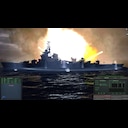ติดตั้ง Steam
เข้าสู่ระบบ
|
ภาษา
简体中文 (จีนตัวย่อ)
繁體中文 (จีนตัวเต็ม)
日本語 (ญี่ปุ่น)
한국어 (เกาหลี)
български (บัลแกเรีย)
Čeština (เช็ก)
Dansk (เดนมาร์ก)
Deutsch (เยอรมัน)
English (อังกฤษ)
Español - España (สเปน)
Español - Latinoamérica (สเปน - ลาตินอเมริกา)
Ελληνικά (กรีก)
Français (ฝรั่งเศส)
Italiano (อิตาลี)
Bahasa Indonesia (อินโดนีเซีย)
Magyar (ฮังการี)
Nederlands (ดัตช์)
Norsk (นอร์เวย์)
Polski (โปแลนด์)
Português (โปรตุเกส - โปรตุเกส)
Português - Brasil (โปรตุเกส - บราซิล)
Română (โรมาเนีย)
Русский (รัสเซีย)
Suomi (ฟินแลนด์)
Svenska (สวีเดน)
Türkçe (ตุรกี)
Tiếng Việt (เวียดนาม)
Українська (ยูเครน)
รายงานปัญหาเกี่ยวกับการแปลภาษา


















































































I don't know exactly what you're having problems with, but remember that you have no towed array in '68, so you need to nose towards your targets. Mix between above and below the layer to get a better ear on the situation. If you do find one submarine, keep in mind that they tend to sail in a pattern, like 3 submarines will always be an equilateral triangle, and if they're protecting a boomer, it's always directly in the middle of the triangle at the start, so you can generally guess where the others are. If you're playing with Soviet sub mods, remember they have weaker sonar.
If all else fails, give a ping of active sonar or shoot an active torpedo into areas in that possible triangle you can't reach - that tends to get them to make noise.